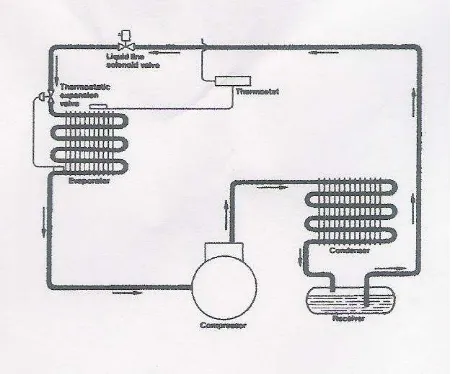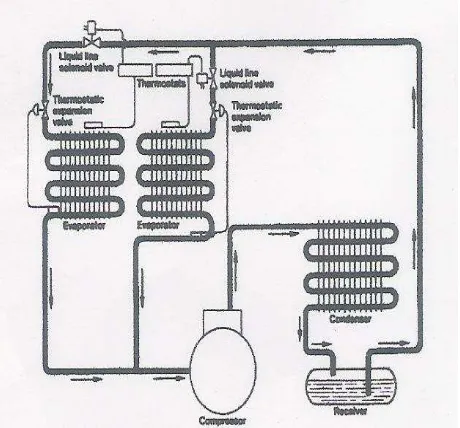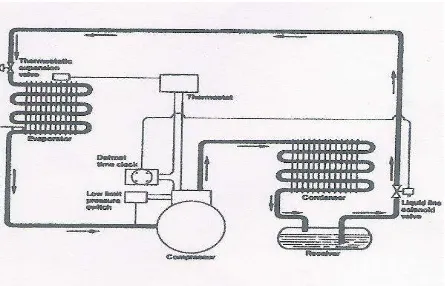ii
EMBEDDED CONTROLLER DESIGN FOR EVAPORATOR SYSTEM
MUHAMMAD FIRDAUS ABDUL RAHIM B010410092
This Report Is Submitted In Partial Fulfillment of Requirements for The Degree of Bachelor In Electrical Engineering (Control, Instrumentation and Automation)
Faculty Of Electrical Engineering Universiti Teknikal Malaysia Melaka
i
“I hereby declared that I have read through this report and found that it has comply the partial fulfillment for awarding the degree of Bachelor of Electrical Engineering
(Control, Instrumentation and Automation)”
Signature : ………..
Supervisor’s Name : Pn. Sahazati Binti Md. Rozali
iii
“I hereby declare that this report is a result of my own work except for the excerpts that have been cited clearly in the references.”
Signature :………
Name : MUHAMMAD FIRDAUS ABDUL RAHIM
IC No : 851201-14-5501
iv
v
ACKNOWLEDGEMENT
Praise to Allah S.W.T, The Almighty who gives me the strength to finish and complete this Final Year Project on time. First of all, I would like to thanks to my parent, En. Abdul Rahim bin Hashim and Pn. Noor Hayati binti Ibrahim who help, motivate, and support me in completing this Final Year Project.
Special honour and thankful greeting to my supervisor, Pn Sahazati binti Md Rozali who has helped me in many ways such as giving opinions, helping directly with solutions and brainstorming discussion in completing this Final Year Project.
Besides, I also would like to thank to individuals and groups who give a lot of cooperation in sharing their knowledge and expertise with me. Mohd Shahril Alias, Mr Yu Kee Thung, Mr Chye Ching Hock, Mohd Faizal Muhammadon, Mohd Hafifi Muhammad Hanafiah, Zulmajd Hamdan, Mohd Adam Sapee and mechanics of Elite Car Air-Cond and Accessories. Special thanks to all of them.
vi
ABSTRACT
vii
ABSTRAK
xi
6.1 DISCUSSION OF PROJECT OBJECTIVE 74
6.2 DISCUSSION OF PROJECT SCOPE 75
6.3 DISCUSSION ON METHODOLOGY 76
6.4 ADVANTAGES OF PIC CONTROLLER 76
xii
7.0 CONCLUSION 78
8.0 REFERENCES 80
xiii
LIST OF FIGURES
FIGURE TITLE PAGE
2.1 The Evaporator Temperature Controller 7
2.2 Thermostatic Control of Two Separate Evaporators 8
2.3 Defrost Pump Down 9
2.4 Split Evaporator-Humidity Control 10
2.5 Heat Reclaim Serial system 11
2.6 Heat Reclaim Parallel System 12
2.7 Air-Conditioner System Operation 13
2.8 Car Air-Conditioner System 14
2.9 Freezers 17
2.10 PIC Circuit 24
2.11 Connection and Interface of I/O 25
3.1 PIC16F877A 33
5.10 Uploading C Language Program using CD2M Software 60
5.11 PCW C Compiler Software 62
xiv
5.13 Hyper Terminal of 1.57 Volt 65
5.14 Hyper Terminal of 2.24 Volt 66
5.15 Hyper Terminal of 3.97 Volt 67
5.16 Hyper Terminal of 4.84 Volt 68
1
1.0 INTRODUCTION
EMBEDDED CONTROLLER DESIGN FOR
2
1.1 INTRODUCTION OF PSM PROJECT
This project is created to design an evaporator system that control car air-conditioner automatically using microcontroller (PIC). This project is the combination of electrical, electronics and mechanical engineering field to represent the new invention which is regarding the design and development process.
This project is conducted in order to overcome the problem of the original system. The old design of air-conditioner evaporator controller needs combination of two systems to start the application of blower that is the major part in evaporator system. This new design only needs one system to allow the car air-conditioner evaporator to operate with the swing from blower part. This new design provides more advantages compared to the original system.
As for evaporator air-conditioner system, this parts of air-conditioner system can control many variables and applications that is important in order to complete the function of car air-conditioner system. It can control temperature, thermostatic, defrost pump down, defrost low ambient condition, heat, humidity, capacity system and liquid line.
3
1.2 PROJECT OBJECTIVE
• To construct, design and fabricate evaporator air-conditioner system that consists hardware parts and software program.
• To learn and develop PIC (Peripheral Interface Circuit) controller to control the operation of evaporator system.
• To implant together both hardware parts and controller system that has been designed.
• To learn more on installation and troubleshooting.
1.3 PROJECT SCOPES
• Make a hardware installation that indicates wiring, soldering, testing and troubleshooting for both evaporator system and PIC controller.
• Design the controller (PIC) programming with micro-controller (PIC16F877A) using C language.
• Determine the suitable sensor to control the blower part in evaporator air-conditioner system.
4
1.4 PROBLEM STATEMENT
Previous controller for air-conditioner system used combination of thermostat and timer system. It uses many hardwire connections and the accuracy for its operation is decrease by time. The operation will less in persistent and for further time, it will affect the consistency of air-conditioner system. As for evaporator system, with the previous controller, the controlling of its blower with the using of timer will affect the overall operation of evaporator system.
The older design has complex hardwire system.
The older design needs combination of thermostat and timer system. The older system is less in accuracy of controlling operation.
The implementation of the older control system is fixed.
1.5 PROBLEM SOLVING
For evaporator air-conditioner system, the new controller will be design with PIC controller using micro-controller PIC16F877A with c-language. This controller will reduce the using of hardwire connections. With this controller, the persistent of its operation will maintain for long timeframe.
The new design will reduce hardwire connection.
5
6
2.0 LITERATURE REVIEW
First step in developing a new controller for air-conditioner evaporator system is to do research regarding the evaporator system, the older design of controller system and the suitable programmable controller for future design. The knowledge, application and implementation from this whole system will evaluate the perfect controller system in completing this project. This literature review parts will provide and explain the concept of air-conditioner evaporator system and its controller.
2.1 JACKES-EVANS EVAPORATOR CONTROLLER
7
2.1.1 The Evaporator Temperature Controller
The Evaporator Temperature Control has a solenoid valve installed in the liquid line as close to the evaporator as possible, that is in conjunction with a narrow differential thermostat. It is an excellent temperature control. By mounting the thermostat bulb in the supply or discharge air across the evaporator, the temperature swing is limited only by the differential of the thermostat. Figure 2.1 represent the evaporator temperature controller. It shows the connection between equipment and flowing of temperature swing of compressor, condenser, evaporator and thermostatic valve. The valve is installed close to evaporator.
8
2.1.2 Thermostatic Control of Two Separate Evaporators
The Thermostatic Control of Two Separate Evaporators is a type of temperature that can be used on a single or multiple evaporator system and is particularly useful on multiplexed systems with evaporators at different temperatures. Figure 2.2 represent the construction of two separate evaporators with thermostatic control. The flowing of liquid start with compressor through condenser and then it separate to both evaporators.
9
2.1.3 Defrost Pump Down
The Defrost Pump Down is a situation where the condensing unit is installed in a low ambient such as on a rooftop. The evaporator is operating at a temperature above the ambient and will detract the pump down solenoid valve. This allows the pressure control to be asset at a cut out of 1 to 2 psi and the cut in to be set at a pressure below the pressure corresponding to the ambient temperature. This will insure the condensing unit will start after cooling down during defrost. When a system has a defrost pump down solenoid valve, a thermostat should be used in series with the time clock defrost to control the temperature. An alternative to the thermostat would be an evaporator pressure regulator.
Figure 2.3 represent the connection of defrost pump down that consists of three main part of compressor, condenser and evaporator. The evaporator will detract the pump down solenoid valve.
10
2.1.4 Split Evaporator-Humidity Control
The Split Evaporator-Humidity Control is a type of controller that is related to humidity. There are often times when air temperature is satisfactory but the humidity level is too high. This can be remedied by using half the evaporator to dehumidify the air without excessive cooling and the addition of auxiliary heat. This can be accomplished by using a normally open solenoid valve on one half of the evaporator controller by a humidistat.
Figure 2.4 represent the split evaporator humidity control. This type of controller is controlling humidity with its two split evaporators. The flowing of liquid from compressor to evaporators is accomplished by normally open solenoid valve. From the figure, the split evaporators is separate for satisfactory of humidity level.



